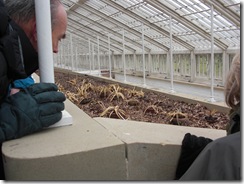Let me start by saying that I was given this book by the publishers to review, but this has no effect on my comments.
Kitchen Garden Estate is a bit of a strange beast. Its sub-title is “Traditional country-house techniques for the modern gardener or smallholder”, but if you are looking for a practical guide to running your own smallholding or even for growing your own, then this, perhaps, is not the book for you. If, however, you have an interest in garden and estate history in relation to food production then this will be of interest. Having visited a few estates, and enjoyed looking at the productive gardens, I have to say I did enjoy this book very much. I won’t however, be transferring much of this to my day-to-day allotmenteering, though I must admit I do now hanker after a
bee house.
After a brief historical introduction to growing your own, the author examines the development of the production of the range of foods grown on the grand estates of England and Wales. Alongside this we are provided with sample recipes from National Trust archives and contemporary authors. I'm very tempted to make the plum, apple and pear cake but rather less tempted by the eel recipe from Izaak Walton. Call me a wuss, but any recipe that requires you to re-slide the skin back over your meal before securing it where the head would have been if you hadn't just cut it off has me reaching for a ready meal instead.
The development of fruit and vegetable gardens over time, including overseas influences, is examined. The change from place of beauty to hidden utilitarian workspace (though often no less beautiful, with serried ranks of perfect veg and espaliered fruit) is charted as garden fashions change and landscaped parklands become more common. And it's always nice to read the story about Lord Leconfield and his banana.
Pinery at Tatton Park
Melon yard at Spetchley Park
Trained fruit trees at Tatton Park
It was interesting to see mention of
'crinkle crankle' walls, which I had come across when I lived near Suffolk (where they are common) but I didn't know the reason behind this style of wall until now.
Of course, most people don't have a walled garden. Nor do many have an orangery, such as that at Croome Park - estate owners in former times were keen to ensure that buildings in the landscape were beautiful as well as functional. This orangery was designed by Robert Adams, and had an underfloor heating system.
The orangery at Dunham Massey is not quite as grand, but still rather impressive - which was rather the point.
The author makes comment that little is new in the area of gardening and food production - the recent trend for forest gardening has been around for a long time.
Other areas covered include beekeeping, fishponds, dovescotes and poultry, and dairying. As someone who has some knowledge of modern dairy processing plants, it was fascinating to see what an 18th century dairy looked like - a thing of beauty with Wedgewood tiles and dishes. Sadly nowadays, it's all stainless steel - easier to keep clean, but utility writ large, and most certainly not a thing of beauty.
Whilst many of us might be able to make use of some of the fruit and veg growing techniques used in large estates, and even urban hen-keeping is relatively common, few can hope to have their own stew pond, dairy, model farm or deer park. This is perhaps where the sub-title of the book falls down.
Part history book, part gardening/smallholding book, part cookbook, supported by historical images, this is a book which may try a little too hard to jump on the 'grow your own' bandwagon. However, as a very readable look at how food production has developed over the years on large estates, it is very interesting.
Rather posh fish pond at Croome Park
Deer in my back garden Tatton Park
We might not be able to fit a deer park or a stew pond into the modern garden, but it's somehow nice to know that I grow some vegetables that the Tudors considered 'deintie dishes'. Thanks to this book, I can make that link to the past.
Kitchen Garden Estate - traditional country-house techniques for the modern gardener by Helene Gammack, published by National Trust. ISBN 97819078929127
(All photographs in this post are my own).







